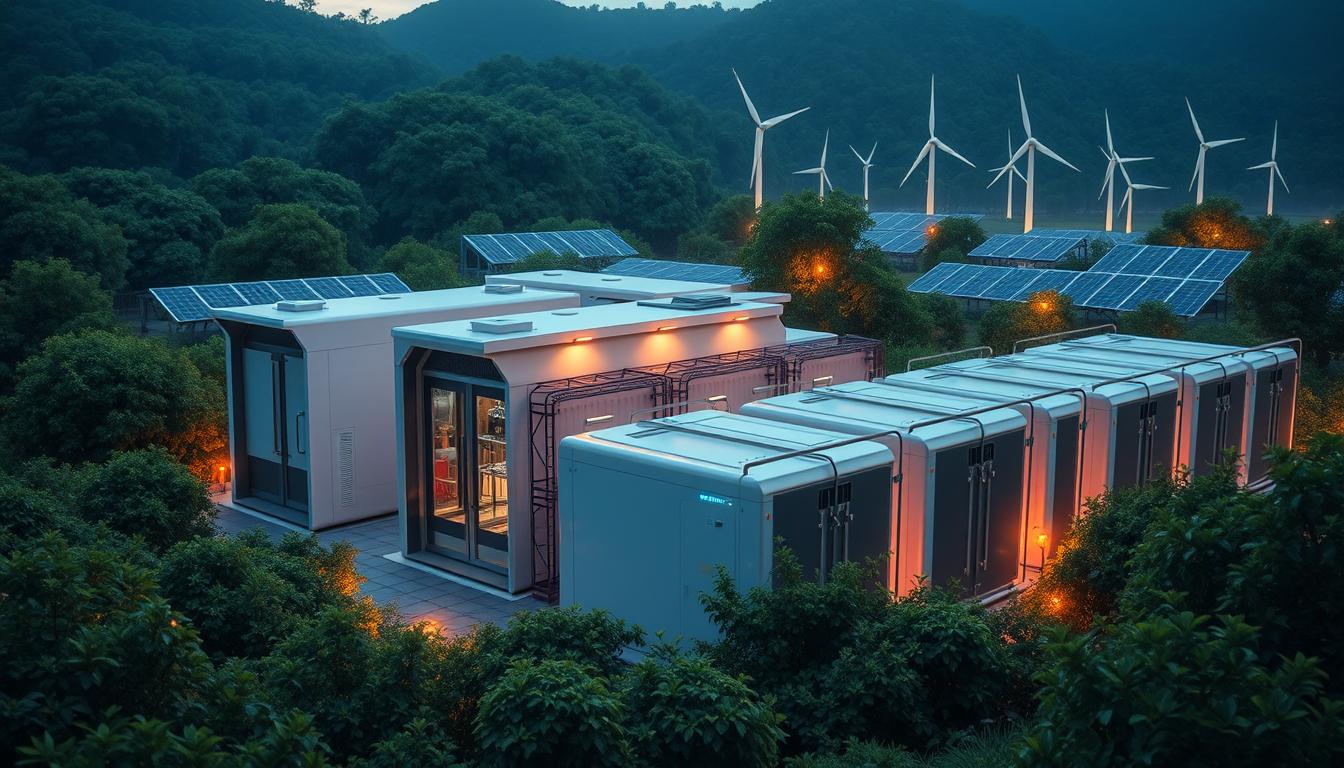The global energy storage market CNESA is evolving rapidly, fueled by the China Energy Storage Alliance. In 2021, the world’s energy storage capacity reached 17 GW, marking an astonishing 185% increase from the previous year. This surge underscores the crucial role of energy storage in achieving a sustainable energy future.
Renewable energy like solar and wind is becoming more important. But, we need reliable ways to store energy. CNESA is leading the way, making sure the grid stays stable. They’re helping us use more renewable energy without problems.
Key Takeaways
- The global energy storage capacity reached 17 GW in 2021, a remarkable 185% increase from the previous year.
- CNESA plays a pivotal role in driving sustainability and growth in the global energy storage market.
- The integration of intermittent renewable energy sources and grid stability are key focus areas for CNESA.
- Advancements in energy storage technologies, such as lithium-ion batteries, are enabling the transition to a more sustainable energy future.
- Regulatory policies and incentives are crucial in driving the adoption of energy storage solutions worldwide.
The Rise of Renewable Energy and Grid Stability Challenges
The world is moving towards a greener future, focusing on solar and wind power. But, these sources are not always steady, causing problems for the power grid. We need new ways to keep the power flowing smoothly and efficiently.
Integrating Intermittent Renewable Sources
Adding solar and wind power to the grid can make it unstable. This can lead to power quality issues and reliability problems. It’s key to find solutions to these issues for a renewable energy future.
The Role of Energy Storage in Grid Stabilization
Energy storage systems are vital for keeping the grid stable. They use technologies like lithium-ion batteries to store energy when it’s plentiful. Then, they release it when we need it most. This helps keep the power flowing smoothly.
Combining renewable energy integration, grid stability, and energy management systems is crucial. As we use more distributed energy resources, energy storage will play an even bigger role. It’s essential for a reliable and green smart grid infrastructure.
| Renewable Energy Integration Challenges | Role of Energy Storage in Grid Stabilization |
|---|---|
|
|
“Integrating renewable energy sources into the grid is crucial for a sustainable future, but it also introduces challenges that must be addressed through innovative solutions like energy storage.”
Lithium-Ion Batteries: The Backbone of Energy Storage
Lithium-ion batteries are key in the fast-changing world of energy storage. They power everything from electric cars to big energy storage systems. These batteries help use more renewable energy and make the grid more stable worldwide.
Lithium-ion batteries are popular because they are versatile and affordable. Thanks to new tech, they hold more energy, charge faster, and work better. This makes them a top pick for storing energy.
| Metric | Lithium-Ion Batteries | Lead-Acid Batteries |
|---|---|---|
| Energy Density | 100-265 Wh/kg | 30-50 Wh/kg |
| Cycle Life | 500-10,000 cycles | 200-500 cycles |
| Efficiency | 85-98% | 70-92% |
Lithium-ion batteries have many benefits. They pack a lot of energy, last a long time, and charge well. As we need more renewable energy and stable grids, these batteries will be even more important for a green future.
“Lithium-ion batteries have become the cornerstone of the global energy storage market, enabling the widespread adoption of renewable energy sources and enhancing grid stability worldwide.”
Distributed Energy Resources and Energy Management Systems
The energy world is changing fast. Now, we’re using distributed energy resources (DERs) and energy management systems (EMS) in new ways. These technologies improve power quality and cut costs for everyone.
Enhancing Power Quality and Reliability
DERs like solar panels and wind turbines are making the grid better. They work with EMS to manage energy well. This makes sure we always have power, even when it’s needed most.
Optimizing Energy Consumption and Costs
- EMS use smart tech to help us use less energy. This way, we can save money on our bills.
- With DERs and EMS, we can use energy wisely. This means lower bills and better energy use.
- Grid operators also save money. They can manage energy better, which is good for everyone.
| Feature | Benefit |
|---|---|
| Distributed Energy Resources (DERs) | Improved power quality and reliability through the integration of renewable energy sources and energy storage systems |
| Energy Management Systems (EMS) | Optimized energy consumption and reduced costs for consumers and grid operators through real-time monitoring, control, and analytics |
DERs and EMS are changing the energy game. They bring better power, reliability, and savings. This is a step towards a greener, stronger energy future.
Cost-Effective Storage Technologies and Smart Grid Infrastructure
The world’s energy needs are changing fast. We need better storage and smart grids more than ever. New battery systems are key to a green energy future.
Advancements in Battery Storage Systems
The energy storage market has grown a lot lately. This is thanks to better battery tech. Now, we can store energy more efficiently and use more green energy.
New types of batteries are coming out. Like lithium-ion, flow batteries, and solid-state batteries. These changes help meet our growing energy needs.
- Improved energy density and storage capacity in lithium-ion batteries
- Advancements in flow battery technologies for large-scale energy storage
- Promising solid-state battery solutions with enhanced safety and reliability
- Increased affordability and accessibility of battery storage systems
New battery tech is making grids smarter. It helps mix more green energy into our power. This makes power flow better and keeps it steady for everyone.
“The energy storage market is poised for significant growth, driven by the increasing adoption of renewable energy and the need for reliable, cost-effective grid-scale storage solutions.”
The link between storage and smart grids is vital as energy needs keep changing. With better batteries, we can make energy systems more reliable and green. This helps everyone.
Regulatory Policies and Incentives Driving Adoption
The world’s energy scene is changing fast. Rules and monetary incentives are key to making energy storage tech more popular. Governments see energy storage as vital for using more renewable energy and stabilizing the grid.
Supportive rules are a big push for energy storage. Policymakers have set up incentives and rules to get more energy storage systems out there. These include:
- Tax credits and rebates for energy storage installations
- Utility-led programs that offer energy storage incentives
- Mandates for utilities to procure a certain percentage of energy storage capacity
- Streamlined permitting and interconnection processes for energy storage projects
Energy storage’s role in modernizing grids and adding renewable energy is growing. New rules are being made to help energy storage fit into the energy world.
| Regulatory Policy | Impact on Energy Storage Adoption |
|---|---|
| Energy Storage Mandates | Require utilities to procure a specific amount of energy storage capacity, driving investment and market growth |
| Investment Tax Credits | Provide financial incentives for the installation of energy storage systems, reducing upfront costs |
| Time-of-Use Pricing | Encourages energy storage deployment to optimize energy usage and reduce costs during peak demand periods |
As the energy storage market grows, rules and money incentives will play a big role. They will help make this tech a big part of our future energy system. This will lead to a greener and more stable energy world.
Global Energy Storage Market CNESA: Market Analysis and Trends
The global energy storage market has seen fast growth lately. This is thanks to more use of renewable energy and the need for stable grids. The China Energy Storage Alliance (CNESA) has been key in guiding this market, offering important insights and analysis.
Key Players and Investment Trends
The energy storage market has many important players. Each one is helping the industry grow. CNESA reports show big investment trends changing the market. Companies are spending on research to make storage better, more efficient, and cheaper.
| Key Player | Market Share | Investment Focus |
|---|---|---|
| Tesla | 20% | Lithium-ion batteries, grid-scale storage solutions |
| Siemens Gamesa | 15% | Hybrid energy storage systems, offshore wind integration |
| LG Chem | 12% | Residential and commercial energy storage systems |
| Fluence Energy | 10% | Grid-scale battery storage, utility-scale renewable integration |
These trends, as CNESA reports show, highlight energy storage’s growing role. It’s key in our shift towards a greener, more stable energy future.
“The global energy storage market is set for huge growth. This is because of more renewable energy and the need for solid grid systems. CNESA’s analysis and insights are vital for those in the industry to keep up with these changes.”
Grid Stability Solutions for a Sustainable Energy Future
The world is moving towards sustainable energy, and grid stability is key. Solar and wind power are becoming more common. But, they bring challenges to keeping the power system reliable. Energy storage is a crucial solution for a stable energy future.
Energy storage systems are essential for grid stability. They balance electricity supply and demand. They store extra energy when there’s too much and release it when there’s not enough. This keeps the grid stable and the power supply reliable.
Enhancing Grid Resilience with Energy Storage
Technologies like lithium-ion batteries and flow batteries offer grid stability. They help in several ways:
- They quickly adjust to changes in grid frequency, keeping power stable.
- They regulate voltage, ensuring power quality is good, even when demand changes.
- They store extra energy from renewables and release it when needed, making renewables more reliable.
Energy storage is key to using more renewable energy. It’s helping us move towards a greener future.
| Grid Stability Solution | Description | Key Benefits |
|---|---|---|
| Frequency Regulation | Rapid response to changes in grid frequency to maintain stability | Consistent power supply, improved power quality |
| Voltage Support | Regulation of voltage levels within acceptable limits | Stable and reliable power delivery, enhanced power quality |
| Capacity Firming | Storage of excess renewable energy for release during periods of low production | Increased reliability of renewable energy sources, improved grid stability |
Energy storage is crucial for using more renewable energy. It’s helping us move towards a greener future.
Emerging Markets and Opportunities in Energy Storage
The world’s energy scene is changing fast, and new markets are showing great promise for energy storage. These areas are key to solving big energy problems. They are expected to drive the energy storage industry’s rapid growth.
Addressing Energy Transition Challenges
Developing countries face big hurdles in using renewable energy. They struggle with keeping the power grid stable. Energy storage is a crucial solution, helping to smoothly add renewable energy and keep the power flowing.
Clean Energy Initiatives and Market Growth Projections
Worldwide, governments and groups are pushing for clean energy. This push is creating a big need for energy storage tech. Places like Asia-Pacific and Latin America are getting a lot of investment. Experts say the energy storage market will grow a lot, with these areas leading the way to a greener future.
FAQ
What is the role of the China Energy Storage Alliance (CNESA) in the global energy storage market?
The China Energy Storage Alliance (CNESA) is key in making the global energy storage market more sustainable and growing. It’s a leading group that promotes energy storage tech. This helps in using more renewable energy and making grids more stable.
How are lithium-ion batteries transforming the energy storage landscape?
Lithium-ion batteries are changing the energy storage world. They are cheaper, more effective, and widely used. This helps use more renewable energy and makes grids more stable. They are crucial for a greener energy future.
What is the role of distributed energy resources (DERs) and energy management systems (EMS) in the energy storage market?
DERs and EMS are vital in the energy storage market. They improve power quality and reliability. They also help save energy and cut costs for users and grid operators. This makes the market more efficient and cost-effective.
How are cost-effective storage technologies and smart grid infrastructure shaping the energy storage market?
Cost-effective storage tech and smart grids are key to the energy storage market’s growth. Advances in battery systems and smart grids help use more renewable energy. This supports a sustainable energy future.
What is the impact of regulatory policies and incentives on the adoption of energy storage technologies?
Rules and incentives greatly influence the use of energy storage tech. Governments’ support and favorable rules encourage the market. This helps deploy energy storage more widely.
How does the China Energy Storage Alliance (CNESA) analyze the global energy storage market and identify key trends?
CNESA gives detailed insights into the global energy storage market. It spots important players, trends, and developments. This helps everyone understand the market and make better decisions.
What are the grid stability solutions enabled by energy storage technologies for a sustainable energy future?
Energy storage tech is vital for a stable grid in a sustainable future. It helps deal with the ups and downs of renewable energy. This ensures reliable power and makes grids more stable.
What are the emerging markets and growth opportunities in the energy storage industry?
The energy storage industry is growing fast in new markets. As places face energy challenges, storage tech is key. Clean energy plans and market growth mean a bright future for the industry.






But wanna comment on few general things, The website pattern is perfect, the articles is rattling fantastic. “Drop the question what tomorrow may bring, and count as profit every day that fate allows you.” by Horace.
Simply wanna tell that this is very useful, Thanks for taking your time to write this.
I really enjoy looking through on this web site, it contains superb blog posts. “Those who complain most are most to be complained of.” by Matthew Henry.
I appreciate, cause I found just what I was looking for. You have ended my 4 day long hunt! God Bless you man. Have a nice day. Bye
I like the helpful info you provide in your articles. I’ll bookmark your weblog and check again here frequently. I’m quite certain I will learn many new stuff right here! Best of luck for the next!